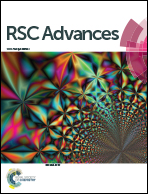Novel mechanisms of the conformational transformations of the biologically important G·C nucleobase pairs in Watson–Crick, Hoogsteen and wobble configurations via the mutual rotations of the bases around the intermolecular H-bonds: a QM/QTAIM study
Abstract
At the MP2/6-311++G(2df,pd)//B3LYP/6-311++G(d,p) level of quantum-mechanical theory, we provide for the first time a comprehensive investigation of the physico-chemical mechanisms of the 55 conformational transformations of the biologically-important G·C nucleobase pairs – Watson–Crick (WC), reverse Watson–Crick (rWC), Hoogsteen (H), reverse Hoogsteen (rH), wobble (w) and reverse wobble (rw) base pairs by the participation of the G and C bases in the canonical and rare tautomeric forms (“r” – means reverse configuration of the base pair). It was established that all these G·C nucleobase pairs can conformationally transform into each other without the changing of the tautomeric status of the G and C bases. These transitions occur through significantly non-planar transition states via the mutual rotation of the G and C bases relative to each other within the G·C nucleobase pair around the upper, middle or lower intermolecular H-bonds: WC ↔ rWC, WC ↔ rwWC, rWC ↔ WC, rWC ↔ wWC, wWC ↔ rwWC, H ↔ rH, H ↔ rwH, rH ↔ H, rH ↔ wH, wH ↔ rwH. Gibbs free energies ΔG of activation for these conformational transformations are ΔG = 2.96–19.04/3.58–13.36 kcal mol−1 (in vacuum under normal conditions (T = 298.15 K)), which means that these reactions proceed quite fast. Obtained conformational transformations are accompanied by the disruption and further formation of the intermolecular specific contacts in the G·C nucleobase pairs (H-bonds and attractive van der Waals contacts). As a result, 76 conformers of the G·C nucleobase pairs were established – 48 base pairs in WC, rWC, wWC and rwWC configurations and 28 base pairs in H, rH, wH and rwH configurations with relative Gibbs free ΔG/electronic ΔE energies in the range ΔG/ΔE = 0.00–44.73/0.00–46.99 and ΔG/ΔE = 0.00–37.52/0.00–38.54 kcal mol−1, respectively (in vacuum under normal conditions). Experimental investigation and verification of the novel G·C nucleobase pairs are promising tasks for the future research. Based on the obtained data, biologically important conclusions were made about the importance of the conformational mobility of the G·C nucleobase pairs for the understanding of the functioning of the DNA and RNA molecules and their transition from the parallel into the anti-parallel duplexes and vice versa.



 Please wait while we load your content...
Please wait while we load your content...